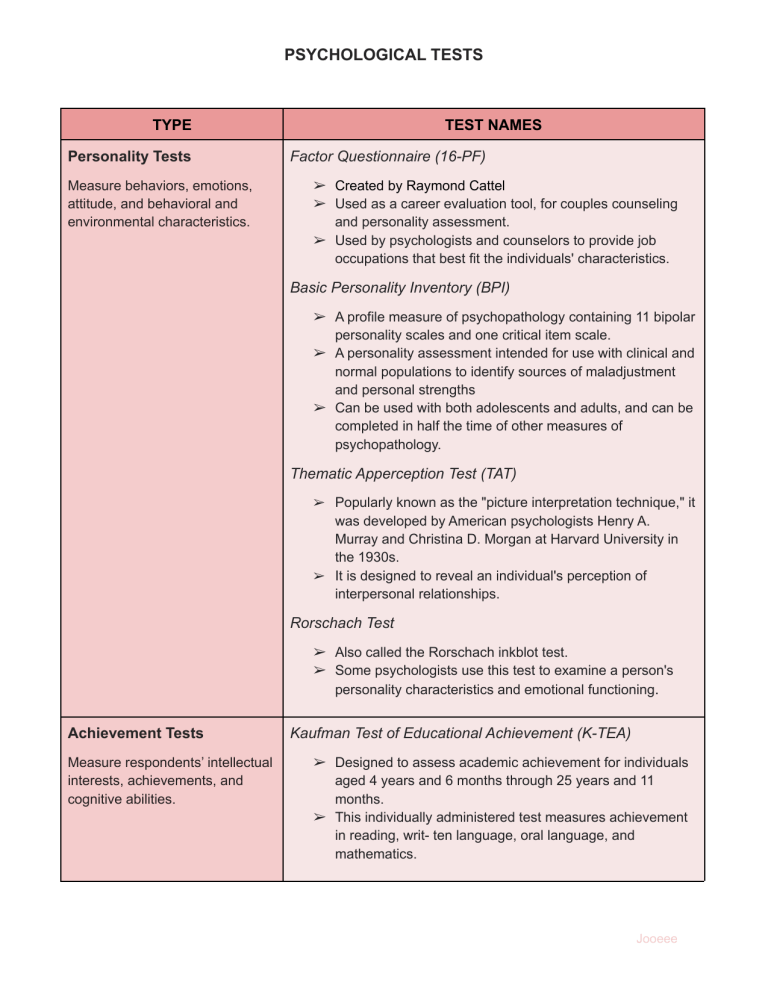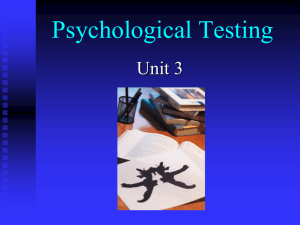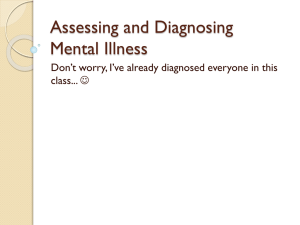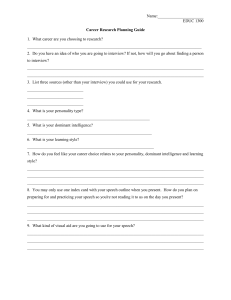
PSYCHOLOGICAL TESTS TYPE Personality Tests Measure behaviors, emotions, attitude, and behavioral and environmental characteristics. TEST NAMES Factor Questionnaire (16-PF) ➢ Created by Raymond Cattel ➢ Used as a career evaluation tool, for couples counseling and personality assessment. ➢ Used by psychologists and counselors to provide job occupations that best fit the individuals' characteristics. Basic Personality Inventory (BPI) ➢ A profile measure of psychopathology containing 11 bipolar personality scales and one critical item scale. ➢ A personality assessment intended for use with clinical and normal populations to identify sources of maladjustment and personal strengths ➢ Can be used with both adolescents and adults, and can be completed in half the time of other measures of psychopathology. Thematic Apperception Test (TAT) ➢ Popularly known as the "picture interpretation technique," it was developed by American psychologists Henry A. Murray and Christina D. Morgan at Harvard University in the 1930s. ➢ It is designed to reveal an individual's perception of interpersonal relationships. Rorschach Test ➢ Also called the Rorschach inkblot test. ➢ Some psychologists use this test to examine a person's personality characteristics and emotional functioning. Achievement Tests Measure respondents’ intellectual interests, achievements, and cognitive abilities. Kaufman Test of Educational Achievement (K-TEA) ➢ Designed to assess academic achievement for individuals aged 4 years and 6 months through 25 years and 11 months. ➢ This individually administered test measures achievement in reading, writ- ten language, oral language, and mathematics. Jooeee PSYCHOLOGICAL TESTS Woodcock-Johnson Psychoeducational Battery (Achievement) ➢ A set of tests designed to measure cognitive abilities, scholastic aptitude, and achievement in the areas of reading, mathematics, and written language, in individuals aged 2-95 years. Attitude Tests Measure views of respondents based on how much they agree or disagree with a statement. Likert Scale ➢ Commonly used to measure attitudes, knowledge, perceptions, values, and behavioral changes. ➢ It involves a series of statements that respondents may choose from in order to rate their responses to evaluative questions Thurstone Scale ➢ Measures a respondent's attitude by using a series of “agree-disagree” statements of various weights. These statements help determine not only how a respondent feels, but how strongly they feel that way. Aptitude Tests Measure capabilities, skill sets, and projection of future success. Abstract Reasoning Test ➢ Assesses the ability to identify and interpret patterns. ➢ Measures lateral thinking and fluid intelligence with the objective of finding the accuracy and speed in which you can identify and interpret the relationship between a collection of shapes and patterns. Visual Reasoning Test ➢ Commonly used aptitude tests used by recruiters to assess a candidate's ability to think logically and solve complex problems. Emotional Intelligence Tests Measure emotional responses such as anger, sadness, happiness, and impulsivity. Emotional and Social Competence Inventory ➢ A 360-degree survey designed to assess 12 competencies that differentiate outstanding from average performance at work. Jooeee PSYCHOLOGICAL TESTS Mayer-Salovey-Caruso Emotional Intelligence Test (MSCEIT) ➢ Measures emotional intelligence through an individual's abilities to perceive, comprehend, act on, and manage emotional information. Intelligence Tests Measure mental/developmental learning disabilities. Wechsler Individual Achievement Test ➢ A standardized academic achievement test used to measure previously learned knowledge in the areas of Reading, Written Language, Mathematics, and Oral Language. ➢ The scores are based on age norms. Wechsler Adult Intelligence Scale (WAIS) ➢ An intelligence test first published in 1955 and designed to measure intelligence in adults and older adolescents. Universal Nonverbal Intelligence ➢ Designed to test intelligence (cognitive ability) of children and adolescents ages 5 years 0 months through 17 years 11 months who may be disadvantaged by verbal and language loaded measures. Neuropsychological Tests Measure cognitive abilities like memory, language, and executive functioning. Ammons Quick Test ➢ Used to assess premorbid intelligence. It is a passive response picture-vocabulary test. ➢ It can be administered to the physically handicapped as well as individuals with attention span deficits. Beck Depression Inventory ➢ Evaluates key symptoms of depression including mood, pessimism, and irritability to gauge how intense a person's symptoms are, and it can also be used to detect initial depressive thinking. Beck Anxiety Inventory ➢ Consists of 21 self-reported items (four-point scale) used to assess the intensity of physical and cognitive anxiety symptoms during the past week. Jooeee PSYCHOLOGICAL TESTS Beck Hopelessness Scale ➢ Designed to measure three major aspects of hopelessness: feelings about the future, loss of motivation, and expectations. The test is designed for adults, age 17–80. ➢ Created by Aaron T. Beck Projective Tests Measure feedback from external influences to identify unrealized emotions/conflicts. Rorschach Inkblot Test ➢ Projective method of psychological testing in which a person is asked to describe what he or she sees in 10 inkblots, of which some are black or gray and others have patches of color. ➢ Introduced in 1921 by Swiss psychiatrist Hermann Rorschach. Thematic Apperception Test (TAT) ➢ A projective measure intended to evaluate a person's patterns of thought, attitudes, observational capacity, and emotional responses to ambiguous test materials. ➢ A widely used projective test for the assessment of children and adults. Draw-A-Person Test ➢ A psychological projective personality or cognitive test used to evaluate children and adolescents for a variety of purposes. House-Tree-Person Test ➢ Intended to measure different aspects of personality. Test takers are asked to draw a house, a tree, and a person. The interpretation of these drawings is used to create a picture of the person’s cognitive, emotional, and social functioning. Observation (Direct) Tests Measure immediate observable behavior; performed in a laboratory, clinical, or natural setting. Direct Observation ➢ A method of collecting evaluative information in which the evaluator watches the subject in his or her usual environment without altering that environment. Jooeee


